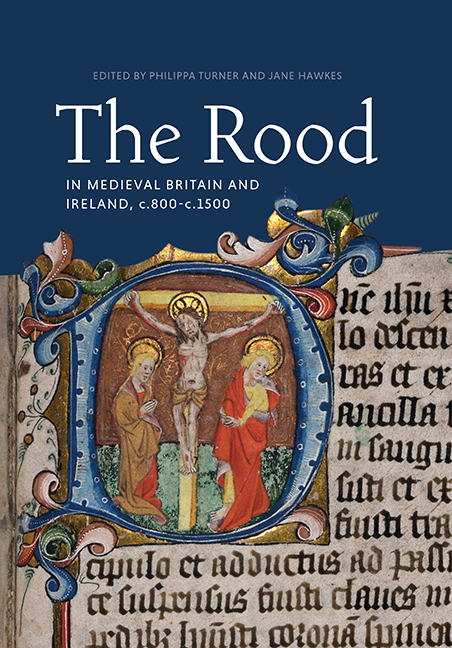Book contents
- Frontmatter
- Contents
- List of Illustrations
- List of Contributors
- Acknowledgements
- List of Abbreviations
- 1 Introduction: Rethinking the Rood
- 2 Approaching the Cross: The Sculpted High Crosses of Anglo-Saxon England
- 3 The Mark of Christ in Wood, Grass and Field: Open-Air Roods in Old English Medical Remedies
- 4 Twelfth-Century English Rood Visions: Some Iconographic Notes
- 5 Crosses, Croziers and the Crucifixion: Twelfth-Century Crosses in Ireland
- 6 From Religious Artefacts to Symbols of Identity: The Role of Stone Crosses in Galician National Discourse
- 7 The Rood in the Late Medieval English Cathedral: The Black Rood of Scotland Reassessed
- 8 The Cross of Death and the Tree of Life: Franciscan Ideologies in Late Medieval Ireland
- 9 Heralding the Rood: Colour Convention and Material Hierarchies on Late Medieval English Rood Screens
- 10 Reframing the Rood: Fifteenth-Century Angel Roofs and the Rood in East Anglia
- Bibliography
- Index
- Already Published
- Plate Section
7 - The Rood in the Late Medieval English Cathedral: The Black Rood of Scotland Reassessed
Published online by Cambridge University Press: 07 November 2020
- Frontmatter
- Contents
- List of Illustrations
- List of Contributors
- Acknowledgements
- List of Abbreviations
- 1 Introduction: Rethinking the Rood
- 2 Approaching the Cross: The Sculpted High Crosses of Anglo-Saxon England
- 3 The Mark of Christ in Wood, Grass and Field: Open-Air Roods in Old English Medical Remedies
- 4 Twelfth-Century English Rood Visions: Some Iconographic Notes
- 5 Crosses, Croziers and the Crucifixion: Twelfth-Century Crosses in Ireland
- 6 From Religious Artefacts to Symbols of Identity: The Role of Stone Crosses in Galician National Discourse
- 7 The Rood in the Late Medieval English Cathedral: The Black Rood of Scotland Reassessed
- 8 The Cross of Death and the Tree of Life: Franciscan Ideologies in Late Medieval Ireland
- 9 Heralding the Rood: Colour Convention and Material Hierarchies on Late Medieval English Rood Screens
- 10 Reframing the Rood: Fifteenth-Century Angel Roofs and the Rood in East Anglia
- Bibliography
- Index
- Already Published
- Plate Section
Summary
The presence of at least one monumental rood, above either the pulpitum or the rood screen, was a standard feature within the late medieval English cathedral. We also have evidence from a number of cathedrals that record the presence of a monumental rood above the high altar. A late thirteenth-century inventory from York Minster, for example, found on the fly-leaf of the York Gospels, records the presence of two roods, one above the pulpitum and one above the high altar, both said to have been donated and dedicated by Archbishop Roger Pont l’Évêque, who was in office 1154‒1181. They are described as holding relics of apostles and Roman martyrs in the corpus of the crucifix, and it is perhaps the case that these relics were brought from Rome by Roger himself, as he is documented as travelling there at least twice. Later evidence from the fabric rolls of the Minster and wills requesting burial within the interior suggests that roods were kept in these positions into the sixteenth century, and it is possible that they were in fact still Roger's twin donation. The image of the high altar of Westminster Abbey in the c. 1532 Islip Roll gives us an indication of how monumental roods above the high altar could look (Fig. 7.1) and extant monumental roods on the Continent, such as that at the cathedral of St Stephen and St Sixtus in Halberstadt, demonstrate their imposing presence above pulpita (Fig. 7.2; Plate VI).
These examples are helpful in reminding us of the most common locations for monumental roods in the cathedral context, and they also suggest, through their similar monumentality, the idea that such roods might have been intended to function in dialogue with one another. In this discussion I intend to examine the evidence for another rood, in a slightly different location within a cathedral interior, which was likely monumental in size, is recorded only in documentary sources, and was lost in the Dissolution or shortly after. It is the rood known as ‘the Black Rood of Scotland’, located in Durham Cathedral Priory, one of the richest monastic institutions in the late medieval north of England and the site of the body and cult of St Cuthbert, centred on the feretory area behind the high altar, where his body was translated in 1104 (Figs 7.3 and 7.4).
- Type
- Chapter
- Information
- The Rood in Medieval Britain and Ireland, c.800-c.1500 , pp. 103 - 124Publisher: Boydell & BrewerPrint publication year: 2020

